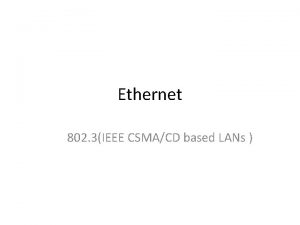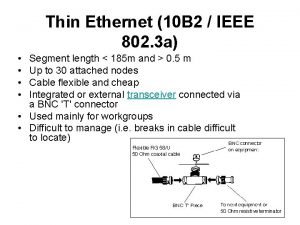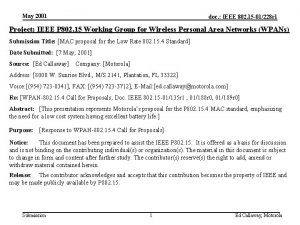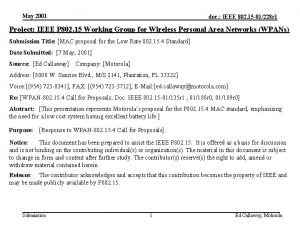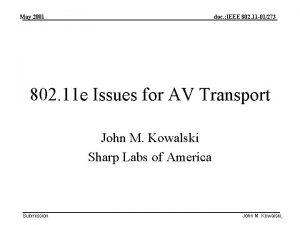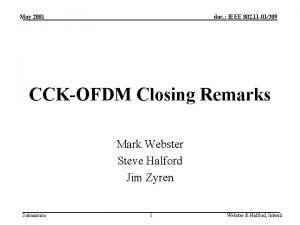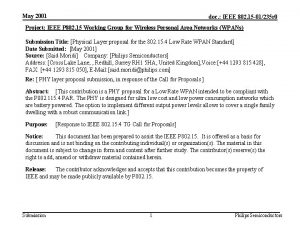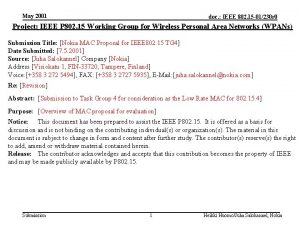May 2001 doc IEEE 802 15 01228 r














- Slides: 14

May 2001 doc. : IEEE 802. 15 -01/228 r 0 Project: IEEE P 802. 15 Working Group for Wireless Personal Area Networks (WPANs) Submission Title: [MAC proposal for the Low Rate 802. 15. 4 Standard] Date Submitted: [7 May, 2001] Source: [Ed Callaway] Company: [Motorola] Address: [8000 W. Sunrise Blvd. , M/S 2141, Plantation, FL 33322] Voice: [(954) 723 -8341], FAX: [(954) 723 -3712], E-Mail: [ed. callaway@motorola. com] Re: [WPAN-802. 15. 4 Call for Proposals; Doc. IEEE 802. 15 -01/135 r 1 , 01/188 r 0, 01/189 r 0] Abstract: [This presentation represents Motorola’s proposal for the P 802. 15. 4 MAC standard, emphasizing the need for a low cost system having excellent battery life. ] Purpose: [Response to WPAN-802. 15. 4 Call for Proposals] Notice: This document has been prepared to assist the IEEE P 802. 15. It is offered as a basis for discussion and is not binding on the contributing individual(s) or organization(s). The material in this document is subject to change in form and content after further study. The contributor(s) reserve(s) the right to add, amend or withdraw material contained herein. Release: The contributor acknowledges and accepts that this contribution becomes the property of IEEE and may be made publicly available by P 802. 15. Submission 1 Ed Callaway, Motorola

May 2001 doc. : IEEE 802. 15 -01/228 r 0 MAC Proposal for the Low Rate 802. 15. 4 Standard Ed Callaway, Member of the Technical Staff Motorola Labs Phone: +1 -954 -723 -8341 Fax: +1 -954 -723 -3712 ed. callaway@motorola. com Submission 2 Ed Callaway, Motorola

May 2001 doc. : IEEE 802. 15 -01/228 r 0 Mediation Device Concept Review • Node duty cycle is reduced to 0. 1% to lower power consumption. • For an asynchronous system, how will two nodes communicate under this low duty cycle condition? • Mediation Devices (MDs), which can record and replay messages, are dispersed throughout the network to enable nodes to synchronize. • MD services may be dedicated (one device serves as MD) or distributed (every device serves as MD at some random time). • Combined with the ALOHA protocol, collisions are unlikely because of the short (1 ms) transmission times. • Refer to doc 01/188 r 1 “Mediation Device Operation” for detailed information. Submission 3 Ed Callaway, Motorola

May 2001 doc. : IEEE 802. 15 -01/228 r 0 MD – A Simple Example 1. 2. 3. Node A sends an “I have traffic for node B” message, but B is sleeping. The MD intercepts node A’s message, including timing information. B When node B checks in with the MD, it finds out that A has a message, and when A A will try to contact again. MD Node B now knows A’s schedule, so they can now sync on the same time slot and start communication. 1 s 1 ms Node A 1 MD 3 MD Listen 2 2 Node B Submission 4 Ed Callaway, Motorola

May 2001 doc. : IEEE 802. 15 -01/228 r 0 Cluster Tree Network Review • A “Designated Device” (Gateway) initiates network formation by choosing Cluster Head 0 (may be separate from DD for reliability). • Network grows via inquiry/inquiry Cluster ID = 1 Cluster ID = 0 scan technique, similar to 15. 1 (join / unjoin simplicity). CH 1 6 20 12 14 5 11 4 8 5 2 13 7 9 • Each device is assigned a DD network address composed of the Designated Device ID, Mesh Topology Cluster ID, and Node ID (total of 24 bits). • Designated device assigns Cluster IDs; cluster heads assign Node IDs. • Refer to doc 01/189 r 0 “Cluster Tree Network” for detailed information. 6 1 4 0 7 2 1 3 9 3 22 10 Submission 5 Ed Callaway, Motorola

May 2001 doc. : IEEE 802. 15 -01/228 r 0 Matrix Criteria • Transparent to upper layers • Ease of Use – 48 -bit address storage available – Join/ unjoin simplicity (with little or no user intervention required) using cluster tree network method – Device registration handled at upper layers • Data Throughput (single cluster) from MAC to higher layer in 1 s – from <<1 to 30 1 -Byte messages / minute • Traffic types – MD handles periodic, intermittent traffic • Topology – Ad hoc network in a mesh configuration – Each network has 255 clusters max; each cluster has 255 devices max – Gateway access through the DD Submission 6 Ed Callaway, Motorola

May 2001 doc. : IEEE 802. 15 -01/228 r 0 Matrix Criteria (con’t) • Reliability – Cluster Head 0 can replace the DD (master redundancy) • Power management – Duty cycle is 0. 1% using MD method • Power consumption of MAC controller – Tx, Rx: 1 m. W – Sleep: 10 u. W • Security – Authentication can be factory encoded for large orders – Encryption is handled in upper layers • Location awareness – implemented in upper layers, but MAC must support (include data in message field) Submission 7 Ed Callaway, Motorola

May 2001 doc. : IEEE 802. 15 -01/228 r 0 Network Simulation Dedicated Device Generations 1 and 4 Generations 2 and 5 Generation 3 -63 nodes -Lines signify parent-child relationship (not communication links) Submission 8 Ed Callaway, Motorola

May 2001 doc. : IEEE 802. 15 -01/228 r 0 Network Simulation Submission 9 Ed Callaway, Motorola

May 2001 doc. : IEEE 802. 15 -01/228 r 0 Protocol Extension • Mesh topology is needed to support inventory management, industrial control and monitoring • For consumer applications, this design can be extended to become a star configuration: NID = even cluster tree network; NID = odd star network (for example) • We can adopt the type of superframe used by the 15. 3 MAC, which provides Guaranteed Time Slots (GTS) for isochronous data (doc. IEEE 802. 15 -01/119 r 1) • GTS provides “guaranteed bandwidth with bounded latency and latency variation” • Also, devices only need to be awake for a fraction of the superframe (low power solution) Submission 10 Ed Callaway, Motorola

May 2001 doc. : IEEE 802. 15 -01/228 r 0 General Solution Criteria Ref Unit Manufacturing Cost ($) 2. 1 Value $2 for 10 M units Interference and Susceptibility 2. 2. 2 30 -2350 and 2. 530 -13 GHz, -50 d. Bm; Adj. Channel (10 MHz), 2400 -2483 MHz, -45 d. Bm Intermodulation Resistance 2. 2. 3 -20 d. Bm IIP 3 Jamming Resistance 2. 2. 4 Can tolerate – • +20 d. Bm 802. 11 b 10 m away • 0 d. Bm 802. 15. 1 1 m away • Microwave ovens in quiet half-cycle Multiple Access 2. 2. 5 Coexistence 2. 2. 6 Submission Low duty cycle systems, interference should be low 11 Ed Callaway, Motorola

May 2001 doc. : IEEE 802. 15 -01/228 r 0 General Solution Criteria Interoperability Ref Value 2. 3 True Manufacturability 2. 4. 1 Single chip solution in development Time to Market 2. 4. 2 Samples available Q 1 2002 Regulatory Impact 2. 4. 3 True Maturity of Solution 2. 4. 4 MD demo and network simulations available SPW and Matlab simulations of CPM Scalability 2. 5 4 of 5 areas listed + network size Location Awareness 2. 6 True Submission 12 Ed Callaway, Motorola

May 2001 doc. : IEEE 802. 15 -01/228 r 0 MAC Protocol Criteria Transparent to Upper Layer Protocols (TCP/IP) Ref Value 3. 1 True Unique 48 -bit Address 3. 2. 1 True Simple Network Join / Unjoin Procedures for RF enabled devices 3. 2. 2 Self-organizing request-grant-ack for network association; no user intervention required Device Registration 3. 2. 3 Handled at upper layers Delivered data throughput 3. 3. 2 <<1 to 30 1 -Byte messages / minute Traffic Types Topology Submission 3. 4 MD handles periodic, intermittent 3. 5. 1 Mesh; parent-child, peer-to-peer 13 Ed Callaway, Motorola

May 2001 doc. : IEEE 802. 15 -01/228 r 0 MAC Protocol Criteria Ref Value Max. # of devices 3. 5. 2 254 clusters; 254 nodes in each cluster Ad-Hoc Network 3. 5. 3 True Access to a Gateway 3. 5. 4 True Master Redundancy 3. 6. 2 True Loss of Connection 3. 6. 3 True Power Management Types 3. 7 MD method using sleep mode (power reduced from 10 m. W to 20 u. W) Power Consumption of MAC controller 3. 8 Tx, Rx: 1 m. W Sleep: 10 u. W Authentication 3. 9. 1 Can be factory encoded Privacy 3. 9. 2 Handled in upper layers Submission 14 Ed Callaway, Motorola












